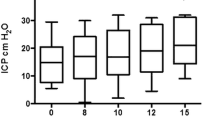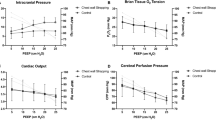Abstract
Background: The effects of pneumoperitoneum on intracranial pressure (ICP) have received relatively little attention. This study was undertaken to investigate the changes in ICP occurring as a result of increased intraabdominal pressure (IAP) and positioning in animals with normal and elevated ICP.
Method: Five pigs (average weight 60 lb) were studied. A subarachnoid screw was placed for ICP monitoring. End tidal CO2 was monitored. Ventilation was performed to keep PCO2 between 30 and 50 mmHg. Measurements of arterial blood gases, mean arterial blood pressure, and ICP were recorded at four different levels of intraabdominal pressure (IAP 0, 8, 16, and 24 mmHg), both in the supine and Trendelenburg positions. A Foley catheter was introduced into the subarachnoid space to elevate the intracranial pressure, and the same measurements were performed.
Results: There was a significant and linear increase in ICP with increased IAP and Trendelenburg position. The combination of increased IAP of 16 mmHg and Trendelenburg position increased ICP 150% over control levels.
Conclusions: Patient positioning and level of IAP should be taken into consideration when performing laparoscopy on patients with head trauma, cerebral aneurysms, and other conditions associated with increased ICP.
Similar content being viewed by others
Author information
Authors and Affiliations
Additional information
Received: 19 March 1996/Accepted: 24 May 1996
Rights and permissions
About this article
Cite this article
Rosenthal, R., Hiatt, J., Phillips, E. et al. Intracranial pressure. Surg Endosc 11, 376–380 (1997). https://doi.org/10.1007/s004649900367
Published:
Issue Date:
DOI: https://doi.org/10.1007/s004649900367




